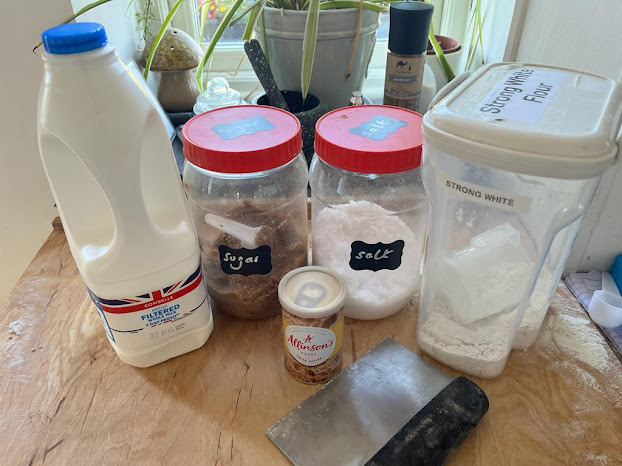The Huffer from Essex
Welcome to another step-by-step recipe from BreadClub20. Why not drop by our main Facebook page by clicking here.... If you like what you see and enjoy the recipe, we hope you go on to join us by 'Liking' and 'Subscribing'.
Many a BreadClub20 baker will tell you of the Kentish Huffkin - its lightness, versatility and how it's perfectly suited to a variety of fillings. (https://breadclub20.blogspot.com/2022/04/kentish-huffkins.html)
Now, meet its Big Brother, the Essex Huffer.
Essex, a county in the East of England, borders Cambridgeshire and Suffolk to the north and sits between London and the North Sea to the east.
The Huffer dates back to the early nineteenth century. It's traditionally a triangular bread 'bap' - if you can call it a bap - originally roughly the size of half a loaf. That's where the name originates. A 'huffer' was the dialectical form of 'half a loaf', especially when delivered in a deep Essex accent.
Nineteenth-century Essex saw an influx of agricultural workers from as far away as Scotland as well as other parts of England. With them, they brought their baking traditions: the barm cakes, the Devon split, morning rolls and cobs.
It's from this rich diversity of baking than the Huffer was born. It would be filled with all manner of meats and cheeses and given to the field workers to sustain them throughout the long days of ploughing, farrowing, seeding and harvesting in what was an important agricultural county.
Today, the huffer is a lot smaller, but still a significant piece of bread and the basis of a hearty sandwich.
I suppose the huffer is to the Essex farmer and agricultural worker what the Cornish Pasty is to the Cornish worker.
Fortunately, recipes for Essex Huffers have been passed down through the generations.
Most require the same key ingredients: strong bread flour, salt, yeast. water and milk.
A few recommend the addition of a little sugar and / or butter (or oil).
This recipe is based on the baking of Kevin Entwistle, known locally in Essex as 'The Huffer Man'. Entwistle is a chef, baker and brewer. It's a prize-winner, by the way, a Huffer that's been sold in its thousands and is held in high regard.
You'll find huffers being sold in Artisan bakeries and on the menu in many local pubs - just the thing to accompany a pint of craft ale.
Give it a try!
INGREDIENTS
750 gms strong white bread flour
300 gms tepid water
300 gms milk (any type)
10 gms sugar (preferably brown)
10 gms sea salt (crushed)
7 gms dried yeast
METHOD
1. Add the yeast to the water, milk and sugar. Stir and leave for 10 minutes to foam on the top.
3. Add the foaming yeast mix to the flour and the salt.
4. Mix thoroughly with a stick (e.g. a wooden spoon, spurtle, spatula, etc.) and then use your hands (claw-like) until you have a rough mix.
Continue to knead until you have a reasonable dough - coming away from the sides of the bowl and developing a 'softness'. This should take five or six minutes of reasonably gentle kneading.
5. Cover with a cloth, plate or shower-cap and leave for about 1½ - 2 hours in a warm room (about 20⁰C).
6. Tip the dough out onto a lightly-floured board and divide into two equal parts.
7. Roll each part out into a circle about one centimetre in thickness.
8. Divide each circle into four quarters.
9. Place the triangular pieces onto a baking tray, cover with a cloth and leave to proof for up to one hour at room temperature.
10. Preheat the oven to 200⁰C
11. Bake for 15 minutes
12. Cool on a rack.
Happy Baking.











Comments
Post a Comment